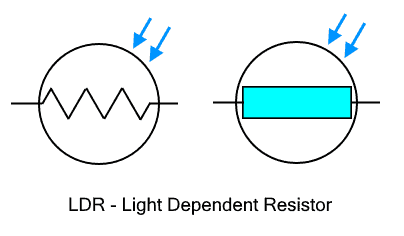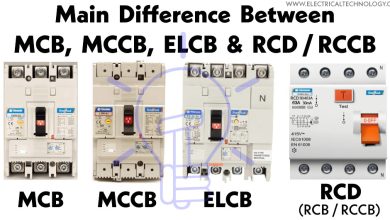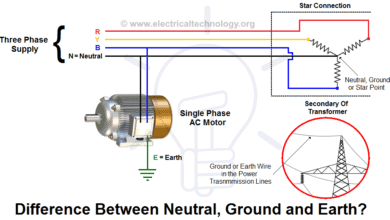Difference between Photodiode and Photoresistor (LDR)
What is the Difference between LDR (Photoresistor) and Photodiode?
Light intensity is one of the seven basic physical quantities that can be measured through various light sensors. Photoresistor (LDR) and photodiode are such electrical sensor that is extensively used in electrical circuits to sense and monitor the intensity of light. Both of them are made of semiconductor material. Apart from that, they are quite different in operation and application.
Before going into the list of differences between LDR and Photodiode, we going to discuss their basics first.
LDR
LDR (Light Dependent Resistor) or also known as photocell or photoresistor is a type of light sensor whose resistance varies with the intensity of incident light. It is essentially a variable resistor made from photoconductive semiconductor material. Its resistance varies inversely with the intensity of light. In other words, its conductivity increases with an increase in light intensity.
It had two identical terminals. Therefore it operates as a bidirectional resistor. It is made from a single layer of N-type semiconductor material that is photoconductive such as Cadmium selenide CdSe, Cadmium sulfide CdS, etc. It works on the phenomenon of photoconductivity.
Photodiode
The photodiode is a type of diode that converts light energy into electrical energy. It is made of semiconductor material that generates current when light falls on it. It is a light sensor or photosensor used for monitoring the intensity of light.
It had two terminals named anode(+) and cathode(-). It operates in reverse bias. Therefore it is a unidirectional resistor. It is a PN junction device made from two layers of semiconductor material. It is manufactured from any semiconductor material not limited to silicon and germanium but its performance depends on the type of material such as response time, sensitivity, dark current and breakdown voltage.
It works on the principle of the photovoltaic effect. When a photon strikes its junction, it generates electron-hole pair, that flow in opposite directions and generates a current called photocurrent. Even under no light conditions, there is a leakage current called dark current. However, it induces errors in the measurement.
Comparison between LDR and Photodiode
The following table shows the key differences between photodiode and a light dependent resistor (LDR).
| Photoresistor (LDR) | Photodiode |
| It is a variable resistor whose resistance depends on the light intensity of incident light. | It is a type of photodiode that converts electrical energy into light energy. |
| Symbol of LDR: |
Symbol of Photodiode: |
| It works on the principle of photoconductivity. | It works on the principle of the photovoltaic effect. |
| LDR stands for Light Dependent Resistor. It is also known as a photoresistor and photocell. | A photodiode is a PN Junction Diode also known as photo-sensor, photo-detector and light-detector. |
| It had two identical terminals. | It has two different terminals anode and cathode. |
| It is a bidirectional resistor. | It is a unidirectional resistor. |
| It operates in either biasing. | It is operated in reverse bias. |
| It is made of a single N-type semiconductor. | It is made of semiconductor PN junction. |
| It has a simple design and is easy to manufacture. | It has a relatively complex design. |
| It is made of photoconductive semiconductors such as CdSe and CdS. | It can be made from any type of semiconductor but its performance depends on it. |
| It has a non-linear response to the intensity of light. | Photodiode has a linear response and its current varies linearly with the intensity of light. |
| It has a slower response time. | It has a very fast response time. |
| It is very cheap and durable. | It is expensive and sensitive to high voltage. |
| It is used in light sensing circuits such as automatic street lights, solar lights, fire alarms, burglar alarms, etc. | It is used in solar panels for green energy, optocouplers for isolations, and in high-speed optical communication. |
- Difference between LED and Photodiode
- Difference Between Photodiode and Phototransistor
- Difference between LED and LDR
Main Differences Between Photoresistor and Photodiode
Definition
- Photoresistor “LDR” is a type of variable resistor whose resistance varies with the intensity of light
- Photodiode is a type of diode that generates an electrical current with incident light.
LDR (photoresistor) is a passive device that does not convert light energy but rather it uses light energy to increase the conductivity of the LDR. On the other hand, photodiode converts light into the electrical energy readily available in solar panels.
Function
- LDR is a light-controlled switch that is used to control current in a circuit using the intensity of light.
- Photodiode is used to convert light energy into electrical energy and precisely measure the intensity of light.
Working Principle
- Photoresistor “LDR” works on the principle of photoconductivity.
- Photodiode works on the principle of the photovoltaic effect.
Photoconductivity is a phenomenon in which photons pass energy to electrons into the conduction band and decrease the resistance of the material. The photovoltaic effect is the phenomenon in which electron-hole pair is generated when a photon strikes a photodiode.
Structure
- Photoresistor “LDR” is made of a single N-type semiconductor layer.
- Photodiode is made of two layers of P-type and N-type semiconductor layers to form a PN junction.
Terminals
- Photoresistor “LDR” has two terminals and both are identical
- The photodiode has two terminals anode and a cathode.
Directionality
- LDR is bidirectional. It can conduct in both directions.
- Photodiode is unidirectional. It only conducts in reverse bias.
Due to the bidirectionality of LDR, it allows AC as well as DC through it. While the photodiode only conducts in one direction i.e. direct current.
Material
- LDR (Photoresistor) is made of cadmium selenide and cadmium sulfide.
- Photodiode is made of any kind of semiconductors such as silicon and germanium.
Response Time
- Photoresistor has a very slow response time.
- Photodiode has a very fast response time.
Due to quick response time photodiode can measure sudden changes in the intensity of light precisely while the LDR can only measure large changes.
Applications
- Photoresistor (LDR) is used in light sensing circuits such as automatic street lights, burglar alarms, and object detection.
- Photodiode is used for generating electrical energy from solar energy in solar panels, high-speed optical communication, optocoupler, etc.
Summary
LDR and photodiode are both photosensors used for measuring the intensity of light. However, LDR is the most used photosensor since it is inexpensive and rugged. Although its slow response time makes it not suitable for sensing sudden changes in light intensity.
On the other hand, photodiode has a very quick response time. LDR is a bidirectional device that can conduct alternating current while photodiode can only conduct DC in reverse bias. If you want to control a circuit using the intensity of light, LDR is the best choice. If you want to detect messages or data encoded in light pulses, photodiode is your choice.
Related Posts:
- Difference Between Thermistor and Thermocouple
- Difference Between Sensor and Actuator
- Difference between Sensor and Transducer
- Difference Between Clipper and Clamper Circuit
- Difference Between Transistor and Thyristor (SCR)?
- Difference between Active and Passive Components
- Difference Between JFET and MOSFET
- Main Difference Between Clipper and Clamper Circuit
- Difference Between D-MOSFET and E-MOSFET
- Difference Between BJT and FET Transistors
- Difference between RTD and Thermocouple
- Applications of Diodes









